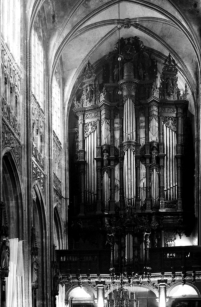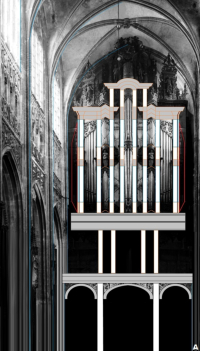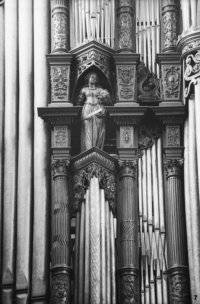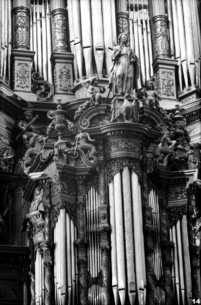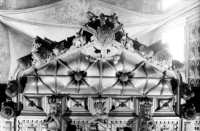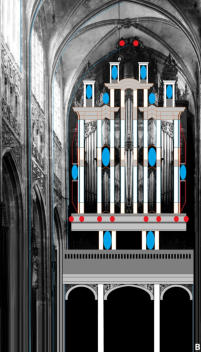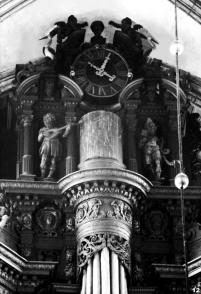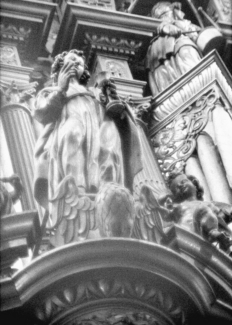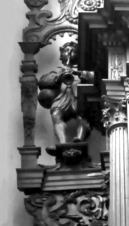
$0.00

Decorative elements of the fassade
of the 17th century organ
of the Saint-Johns Cathedral of Bois-le-Duc
In 1617 the decision was made to build a new organ for the cathedral. The preceding organ dating
from 1540 and build by Hendrick Niehoff was lost in a fire in 1584. The construction of a new
balustrade started as soon as 1617 by the local carpenter Frans Simons.
In 1618 Floris Hoque from Grave started building the new organ. The case of the new organ was also
made by Frans Simonsz along with Georg Schysler from Tirol, who was living in Venlo since 1618.
Floris Hocque died before completing the organ. It was finished by Galtus van Hagerbeer and his son
from Amersfoort.
Although in the course of time much of the inner parts of the organ was changed by a number of
organ builders, the case remained completely untouched. The organ of Bois-le-Duc has one of the
largest and most complete organ casings from the Renaissance.
Hill writes: “ The Bois-le-Duc organ has doubtless the finest case that exists, and it seems
improbable that a greater work of its class could ever be produced”. 1
The lack of a study about this highly decorated case was in 1977 the reason for this description as part
of the study Art history.
the case of the main organ
The case of the main organ rests on four Ionic columns with two statues in between: on the left David
with the harp and to the right Saint Cecilia with her organ. Image A shows the construction of the
case with vertical columns and horizontal entabulatures; image B displays the position of the statues in
blue and the putti in red. The two highest putti are in fact cherubim, because of the wings.
On the four columns an architrave and a ogee shaped frieze, decorated with masks and foliage.
On top of the frieze is another architrave with three bands crowned with a frieze with a convex profile,
decorated with some musical instruments: from the right to the left: rebec, fiddle and bow, a portativ
organ, a triangle an a number of wind instruments: traverso flute, crumhorn and curtail.
The cornice is made of dentils, egg-and-dart molding and a far protruding top list. (image 4)
In line with the columns above it there are eight putti on the entabulature with lute, harp, curtail,
traverso and fiddle, seated on consoles carved with animal masks and acanthus leaves. The corners of
the entabulature are ending in a cul-de-lampe, ornamented with acanthus leaves and hanging on
volutes curling upward with animal masks in between. (image 4)
The entabulature is being supported at both sides by pedestals carved with tendrils, ribbons and
atlants.
the facade pipes
The facade pipes are divided in seven vertical parts by ten columns on each floor; there are two floors,
one for the hoofdwerk and one for the bovenwerk. The outside columns are doubled. (image 5)
The middle tower is semicircular and in two parts with seven pipes in the lower part and eleven
smaller pipes above. This only semicircular tower is flanked on both sides by flat mirror fields or
“spiegelvelden” on two floors; every field has six pipes in the upper row and five pipes in the lower.
Next to these fields are triangular towers with statues between the two floors; there are seven pipes in
the lower part and eleven pipes in the upper one.
The huge outside fields slightly recede and have five pipes both.
De middle pipes of the central tower and both triangular towers are gilded and have ornamental
patterns. (image 6, 9,10)
the columns
The lower half of the main case contains ten Corinthian columns on a high base, each one crowned
with their own architrave, frieze and cornice. (image 3, 6, 7) Each base and frieze is decorated with
carved cartouches, hanging festoons, masks and scrollwork ornamentation.
The columns flanking the two triangular towers have cannelures partially in zigzag or twisted patterns;
the lower part of all columns is richly decorated with scrollwork ornamentation with dentils on top.
(image 3 & 6)
Between the bases of the two outside fields there are panels, richly carved with tendrils and semi-
figures making music; the feet of the pipes have foliage ornaments in between. (image 3 & 6)
On both floors the feet of the pipes of the triangular towers as wel as the centre tower are behind a
row of palmets. On de topside the pipes are covered by pipe shades carved with cherubs which grow
leaf vines. (image 6 & 7)
The “spiegelvelden” on both floors are between the bases ornamented with snakes and tendrils, and
between the friezes with foliage and tendrils. (image 3, 7, 9)
Between the two floors of the triangular towers female statues are standing in arched niches: on the
left side Judith with sword and the head of Holofernes (image 2 &7); on the right side the drum rolling
daughter of Jephta, welcoming her father after his victory. (image 19)
the “bovenwerk”
Standing on the entabulatures of the hoofdwerk are the bases of the ten Corinthian columns of the
bovenwerk, the bases becoming narrower downwards (image 2, 7, 8); the ornamentation of the lower
part of the columns is identical to the lower part of the hoofdwerk columns. (image 8 & 9)
Under the capital the columns of the central tower have a network of splitting cords ending in tassels.
(image 9 & 10)
At the upper side the pipes of the outside fields are covered by leaves and tendrils sprouting from half-
figures. (image 8)
On the four columns on the left and right outside of the bovenwerk rests an entabulature, closely
following the fassade line of the organ and interrupted in the middle. (image 2, 5, 8)
The entabulature of the bovenwerk consist of an architrave with three bands and decorated with
astragalus and fleurons, and a frieze, carved with birds, spreading their wings while standing on
festoons hanging from rings and with a mask crowned with a shell like headdress in the centre.
The cornice of the bovenwerk entabulature has an egg-and-dart molding, a list with consoles
decorated with acanthus leaves and a far protruding, ogee profiled top list with carved fleurons. (image
8, 9, 10)
The extending entabulature of the central tower is placed on the columns on both sides; it is identical
decorated and has cartouches in the frieze with the head of a man and a woman (image 12).
aedicula
The main case is crowned with four aedicula. (image B & 1) Two aedicula are on the central tower with
a round drum and a clock between them. (afb.12) These aedicula have Corinthian columns decorated
with a horizontal band and an entabulature with egg-and-dart molding topped by a semicircular
broken fronton, supported by volutes and covered with chimeras. Inside the fronton a pedestal is
standing on the entabulature of the audiculum, decorated with a men’s face; on the pedestal a
polychromed, outward-facing stork, standing on what appears to be its nest. The storks possibly refer
to the famous “Illustere Vrouwe Broederschap” (Brotherhood of Our Lady), that was involved in the
building process of the organ; on the roof of the house of the Brotherhood in Bois-le-Duc was a stork
nest since 1553. 2 It is noteworthy starks and drum being the only polychromed objects on the organ
case; possibly a clue that the starks are not purely symbolic or decorative, but referring to the real
starks of the Brotherhood.
Sculpted figures are standing in the aedicula: on the left a bearded cyther player and to the right a
man with glasses, book and a curved wind instrument.
The rotating drum has an image of the Dance of Death, depicting men and skeletons, it’s theme being
“Memento mori” (Remember Death). Above it a round dial with roman numerals, topped by a
broken fronton, supported by volutes and with cherubs on top, reaching for the vase placed between
them, the highest part of the organcase.
above the outside fields
In line with the columns of the outside fields and the triangular towers (image 2, 11) and on top op the
entabulature are square columns with decorated panels in between; every column is ornamented with
carving in the shape of a diamond and the panels have a geometrical pattern. The three panels follow
the line of the organcase.
Columns and panels have an architrave with two bands on top, even passing over the console in the
middle of the aediculum.
Above the outside field an aediculum has been placed on this architrave. The columns are atlants,
whose pillars are embellished with a cord hanging on a ring, ending in a tassel and adorned with
ribbons. The atlants are placed on pedestals, downwards getting smaller and having dentils and an
acanthus leave. They support an entabulature, composed of an architrave with four bands, protruding
on both sides, a frieze with sculpted foliage and a cornice with dentils and two bands, the upper one
ogee profiled.
The two free standing statues are female figures, who according tot tradition belong to the attackers
of the wall of Jericho; within the aediculum on the left is a female, wearing a helmet and blowing the
horn; on the right side the woman blows the trumpet, not wearing a helmet.
On top of the entabulature is a festoon hanging between two volutes, supporting a semicircular
pediment. The pediment is intersected on both sides; these objects support festoons, hanging from
the obelisk on top.
On both sides of the aedicula there are supporting carvings. The dentils from the pedestals of the
atlants are continued in these carvings; below the dentils are horned animal skulls and rosettes. Above
the dentils are female figures, volutes and leafage.
On top of the two geometrical decorated panels above the triangular towers a free
standing and half- naked male figure with folded hands is seated, supported by
volutes. (image 11)
At the very end of the main case entabulature a putto, covered with leaves, leans
on a volute while supporting an obelisk-like peak.
Between the organ casing and the church wall there is wood carving over almost
the full height of the case; the carving is placed slightly to the rear and thence hard
to observe.
It is consisting of a number of stacked consoles and including pillars, architraves, arcs, volutes, cords
and semi-figures. Halfway it has a lifesize statue, free standing and making music; to the left a young
man who plays bagpipes (image left) and to the right a bearded old man playing the hurdy-gurdy.
(image 19)
the “rugwerk”
The rugwerk case is separated from the main case and not contained by the balustrade. The design
suggests a later date of construction.
The case was build in the shape of half a hexagon with two star vaults at the basis. (image 16)
The facade has seven parts: one semicircular central tower with five pipes, flanked by two flat fields of
two floors. (image 15) The lower part of the field has nine pipes, symmetrically arranged, and the
upper part is a mirrorfield with six pipes, symmetrical in a row as well. All the towers and fields of the
rugwerk have the labia in a V-formation (see: “labia lines” in the Introduction).
Next are two triangular towers, undivided and with seven pipes, flanked by quarter round fields with
seven pipes. The pipes in the middle of the three towers are gilded and have ornamental patterns
embossed.
The eight columns of the rugwerk are each on a pedestal, ornamented with a mask within a frame;
at the top and bottom the almost square pedestals have three protruding bands.
All columns are identical; only the two columns of the central tower are a bit different. Between the
pedestals are panels adorned with scrollwork carvings; the bands of the pedestals continue over the
panels.
The columns are - like the main case - made up of two vertical layers; however this construction does
not indicate a division in two organs, meaning hoofdwerk and bovenwerk in the main case. This
layout of the columns is purely decorative and imitates only the main case.
The columns have a Ionic base and capital; the shaft has a baroque spiral form and is embellished
with climbing tendrils and hanging grapes.
The lower columns have on their capitals an entabulature, not stretching from column to column, the
same as the columns of the main case. Instead it is functioning as a pedestal for the pillars on top of
it. This entabulature/plinth is composed of an architrave with three bands, a frieze with an acanthus
leafe within a frame and a cornice, decorated with egg-and-dart molding and a console with a lion
mask in front.
Six columns of the top layer are directly on these entabulature/plinths: only the two columns
supporting the central tower have their own pedestal on top of the entabulature/plinth. This pedestal
shows a lion mask without a frame in front and triple bands below and on top.
The columns of the upper layer are half columns. All half columns support the same entabulature; this
entabulature however does not extend over all half columns. The three towers and the two outside
fields each have a part of the entabulature. The central tower stands tallest thanks to the extra
pedestals; the top of the triangular towers equals the lowest part of the central tower entabulature
and the outside fields go by the same formula. The entabulature of the outside fields is supported by
only one column of the first layer of columns; where the outside fields connect with the triangular
towers there is no support for their entabulature.
The entabulatures are identical in shape: an architrave divided in three bands, a frieze with foliage and
a far protruding cornice, decorated with egg-and-darts.
The cornice of the triangular towers acts as the top of the rugwerk case and therefore extends far
back, over the much lower entabulature of the outside fields. The space between cornice and
entabulature is filled by a cherubs, carved in low profile.
Saint John and the eagle
The three towers of the Rugwerk each carry a crowning creation: the cental tower supports two
quarter round, profiled arcs, at the low side starting in volutes, suggesting a tympanon.
Between the arcs a pedestal with a freestanding statue of the apostle John the Evangelist, the
cathedral’s patron saint.
In his hand he carries the chalice with the poison and at his feet his symbol as an evangelist, an eagle
with wings spread.
Next to him are two cherubim, linked to hanging festoons.
Each triangular tower has two ogee shaped, profiled arcs with egg-
and-darts decoration and ending in volutes. Between the arcs a
pedestal topped with a vase, which has a satyr mask in front and
hanging festoons on each side. The festoons are held by rams,
standing on the arcs and holding cords of another festoon that runs
past the pedestal.
The ram is symbol of decisiveness and recklessness; two rams
opposite each other symbolize a conflict. The fact, that two rams are
holding festoons hanging from a vase, generally being a symbol of
victory, may indicate the victory of Saint John in the confrontation
with the supporters and followers of Artemis, when he did not avoid
the fight.
On the bottom of the Rugwerk grapes are hanging in line with the
columns and towers. Below the columns the grapes are attached to
two volutes with a mask in between. Under the central tower a kind of wheel is hanged with six
spokes; between the spokes grapes and fruit are attached to the wheel. From a disk fixed to the
spokes and ornamented with diamond knobs and egg-and-darts the largest grape is hanging, the
lowest point of the organ case.
The helical, Solomonic columns are unique for the Rugwerk. The Rugwerk as a whole is baroque,
mainly by the dynamical movement of the sculptures on top and the almost complete absence of a
straight line in the floor plan. The baroque, spiralling columns with climbing, triumphant laurels of the
famous baldacchino of Bernini in Saint Peter’s Basilica were completed in 1633. It is hardly
conceivable that Schysler, who has to be the sculptor of the Rugwerk, created these columns before
1633, before these columns became famous in Europe. So the Rugwerk dates perhaps after 1633,
with references in it’s sculpture to the Roman church of the Pope. 3
the balustrade
Balustrade and organ casing are supported by two Ionic columns of massive stone without cannelures,
carrying three semicircular arcs, ornamented with sculptures. In the spandrels between the central arc
and the two columns there is depicted on the left side a woman, playing the organ while looking at the
viewer and on the right side a figure playing the violin.
On these columns is an entabulature: an architrave with three bands, a semicircular profiled frieze,
covered with leafage sprouting from halffigures and a cornice with dentils and egg-and-dart molding
(image 13,16,17). On the part of the frieze, that runs under the Rugwerk, is the year 1617 written in
two cartouches.
Consoles are attached to the architrave with masks at the front; below the architrave these consoles
end in an Ionic capital with four volutes combined with ornamental carvings and ending in cul-de-
lampes.
On these consoles are satyrs with musical instruments, their bodies extending over the entire
entabulature. Their heads are between volutes, supporting a row of horizontal cassettes, decorated
with dentils and scrollwork ornamentation (image 18). The Rugwerk is also supported by musical
satyrs, all five of them off a much larger size compared to the satyrs of the balustrade.
The horizontal cassettes are provided with an unsupported entabulature at the front, consisting of an
three-banded architrave, a frieze embellished with angel faces between fruit and foliage and a cornice
with two bands.
Far protruding consoles are attached to this entabulature, in line with the musical satyrs; the consoles
adapted to the underlying form and structure of the entabulature and have framed masks of satyrs
and animals in front.
On these entabulature-consoles are Ionic columns, fluted and with a high basis decorated with figures;
in addition to the columns there are also atlants and herms (image 2). On both sides of the Rugwerk
are first two columns, followed by two herms, which are half the seize of the atlant in between. At the
end of the balustrade is next to the last herm another column, with a second column around the
corner.
Between the columns, herms and atlants are ten panels, the same hight as the herms and the
lower part of the atlants (image 2). The panels have a geometrical ornamentation, the andreas cross
and the greek cross being recognizable.
On top of these panels stands a small arcade, with the exeption of the space between the two pillars
next to the Rugwerk; between these columns the same space is closed by a panel covered by a shell
decoration with cherubs in the spandrels and wickerwork (image 15).
The columns and atlants support an entabulature, consisting of a architrave with three bands, a
decorated frieze anf a far protruding cornice, decorated with an egg-and-dart molding. This cornice is
supported by consoles, resting on the architrave as well as on columns and atlants.
A curious situation seems to exist on the very top of the main organ case: two cherubs are kneeling
there, facing each other, and stretching their hands upwards (image 12). Unfortunately nothing is
there to make this a meaningfull gesture. Between them - hardly visible on a distance of 30 metres is
- on a pedestal - a vase-like object standing, far below the stretching hands. Upon closer
examination this object could be a globe, possibly with a horizon band. By analogy with the
baldacchino in Saint Peter in Rome there could have been a latin cross on the globe, giving the angels
a meaningful purpose.
Rob van Haarlem
Notes:
1 A.G.Hill, The Organ-Cases and Organs of the Middle Age and Renaissance, dl.1 London, 1883, dl.2 London, 1891,
p.17.
2 H.Molhuysen, “Ooievaars”, Brabants Dagblad, 12-04-1990.
3 Bois-le-Duc, one of the main cities of Brabant, was forcefully occupied by the protestants from Holland since 1629.
* all photography is by the author in 1977
Literature:
Berliner, R., Ornamentale Vorlageblätter des 15. bis 18. Hahrhunderts, 3 dln, Klinkhardt & Biermann Verlag, Leipzig,
1926.
Catalogus van Meubelen en Betimmeringen, 3th edition, Rijksmuseum Amsterdam, 1952.
Evans, J., Pattern, a study of ornament in Western Europe, 2 dln, Oxford, 1931.
Jessen, P., Der Ornamentstich, Berlin, 1920.
Hasslinghuis, E., Bouwkundige termen, Oosthoeks Uitgeverij, Utrecht, 1970.
Pevsner, N., An Outline of European Architecture, 7th edition, Penquin Books, Middlesex, 1974.
to the introduction of the cathedral organ of Bois-le-Duc
For more information about the cathedral organ of Bois-le-Duc: www.brabantorgel.nl
page top
